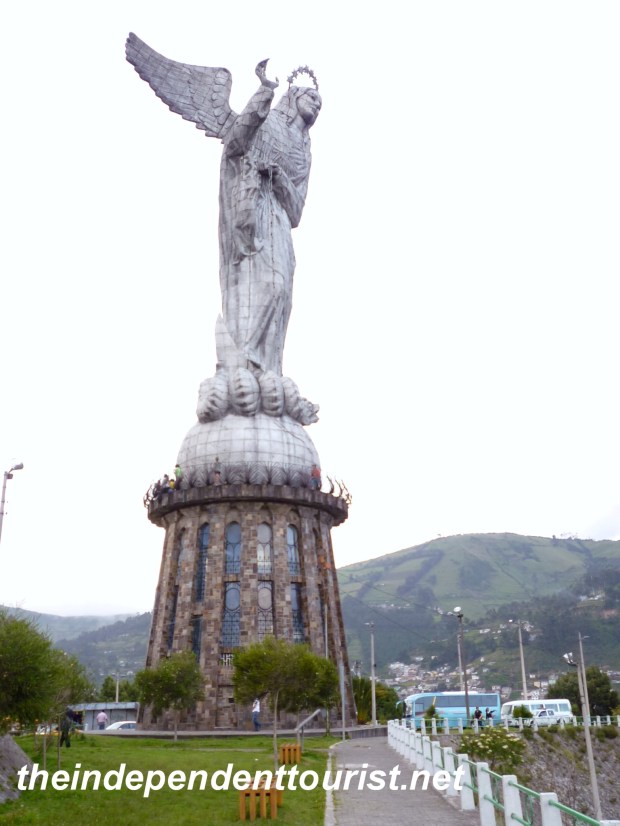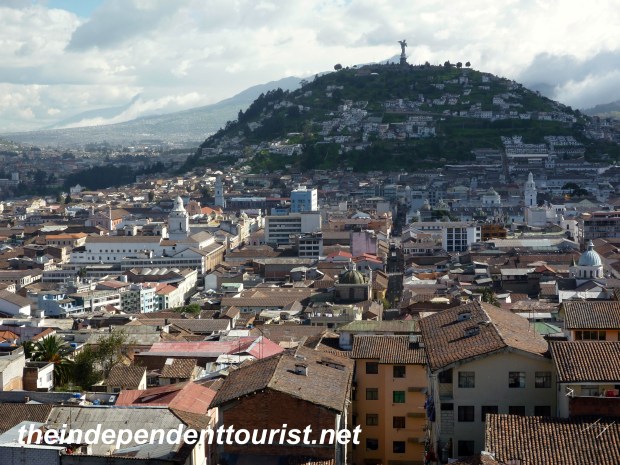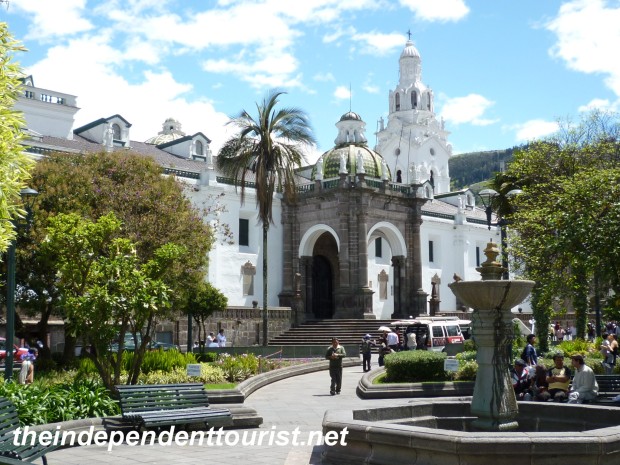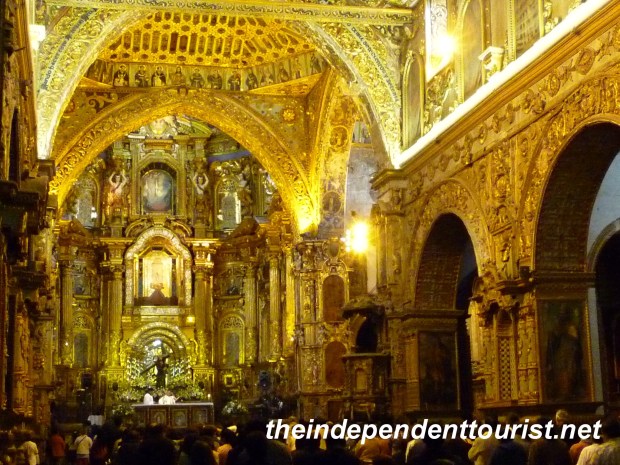As I peered out the window of my plane as it flew into Quito, Ecuador from Lima, Peru I had the feeling that “this is paradise” –green cultivated fields, forests and striking mountains all around, compared with the desert landscape of Lima. Quito is a large city which runs north and south through large valleys and is surrounded by several volcanoes. The northern part of the city is the business center and more prosperous than the south. El Panecillo (‘little bread”) hill separates the two sections of the city and is crowned with a tall statue of the Virgin Mary, facing north, and immediately overlooking the colonial section. The residents of the south lament that the statue is facing north, and overlooking the blessed prosperity of this area while “turning her back on the south.” El Panecillo can be reached by taxi and has some snack and tourist trinket vendors. The views of Quito are excellent from this location.

Virgin Mary Statue on top of El Panecillo.

A view of colonial Quito with El Pancello in the distance.
Quito has the largest Spanish colonial district in South America. In the historical area are several beautiful 16th and 17thcentury Baroque churches, convents, old hospitals, and the presidential palace. According to my business partners this area is slowly being refurbished and brightened up, and has become much more vibrant than a few years ago. The cobblestone streets and colonial facades of the buildings give it an old world feel.

Colonial Quito.
The dominant building in the colonial section is the presidential palace (Palacio del Gobierno), home of the current Ecuadorian president, Rafael Correa. The building is open for tours, but we did not visit. The palace faces the main square, Plaza Grande o de la Independencia. The Cathedral of Quito is also on this square.

Palacio del Gobierno (Presidential Palace).

Catedral Metropolitana de Quito.
Just a couple blocks south and west of the presidential palace are the Church and Convent of San Francisco, dating from 1536, and the oldest existing church in Quito. The chapel is decorated in beautiful gold gilding. The nearby cloisters have an interesting museum of religious art ($2 entry fee) from the 17th – 18th centuries and include paintings and drawings from Europe and many are scenes from the life of St. Frances (born 12thcentury). Also included are some alabaster figures made with real human skulls.

Church of San Francisco, Quito.

Cloisters of San Francisco Convent, Quito.
Unfortunately no pictures are allowed. It was weird seeing these human-like figures of Christ and saints, knowing that they are partially human with the skulls providing the form for the heads!
On the east side of the street (Gabriel Garcia Moreno) in this area is the San Juan de Dios hospital which was founded in 1565 and was in operation until 1965-400 years! I am glad I live in the era of modern medicine.

Hospital San Juan de Dios, Quito.

Hospital life in the 1500’s.
Just north of the colonial section is the gothic Basilica (Basilica del Voto Nacional), which looks like a medieval cathedral right out of France. It is actually just 130 years old and is still under construction (not unlike the cathedrals of Europe, some of which took centuries to complete). One can visit the roof for a small fee which provides great views of the city and colonial section, just a few blocks away. It was interesting to walk along the catwalk above the naïve and then climb the narrow ladders out to the rooftop access.

The Gothic Basilica del Voto Nacional.

View from the rooftop of the Basilica.
Many of the buildings’ exteriors hide the beautiful courtyards contained within. We ate at a restaurant called Cialcote L, part of Cadena Hotelera which provides an example of the courtyard setting inside the building.

Cialcote L Restaurant courtyard.
Other information
Even though it’s almost on the equator, the year-round climate of Quito is very pleasant due to its elevation. Given more time, I would have liked to visit the nearby volcanoes. I stayed at the Radisson hotel, about halfway between the airport in the north part of the city and the colonial old town for about $90 per night. It’s a good hotel with large comfortable rooms and a very good restaurant. At the breakfast buffet, there was a serving container with popped popcorn…it was the first time I had seen popcorn served for breakfast! I wish I would have had my camera handy! Taxis are pretty cheap in Quito, it was only $5 from my hotel to the colonial quarter, about a 15 minute ride, and $7 from the hotel to the airport, about 20 minutes away.
Safety
I was cautioned to pay attention to my small daypack which I carry when touring, which I did, but I never felt threatened or nervous in the colonial Quito, especially in the daytime. There were a few other tourists milling about also, but not many. I took several walks around the hotel at night and felt very safe, that part of the city is modern and feels about like any other large city. As always, pay attention to your surroundings and carry as little cash and valuables as possible.






